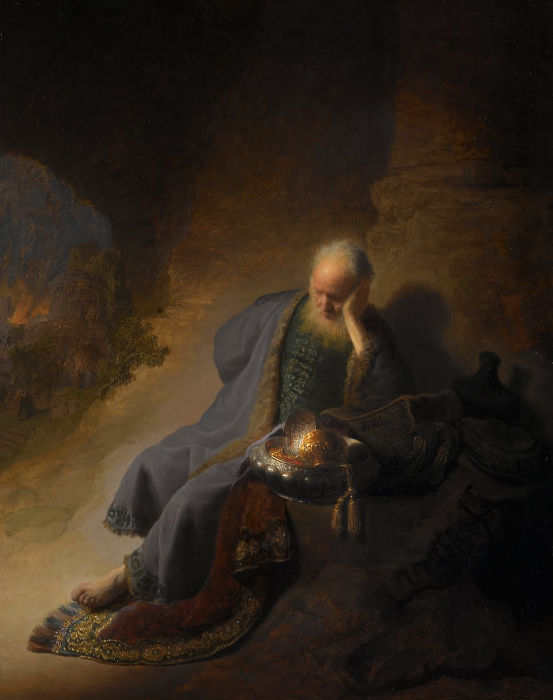 Jeremiah Lamenting the Destruction of Jerusalem, Rembrandt, 1630. Rijksmuseum
Jeremiah Lamenting the Destruction of Jerusalem, Rembrandt, 1630. Rijksmuseum On the wall of the Rijksmuseum hangs Rembrandt’s Jeremiah Lamenting the Destruction of Jerusalem. This work of art captures a weary prophet who is now grieving the previously forewarned and preventable suffering of his people and the destruction of their land. Acclaimed as the Master of Light, Rembrandt’s chiaroscuro achieves a dramatic effect. The dark, seemingly dream-like backdrop, depicts the calamitous consequences of Jeremiah’s unheeded warnings. His people bore cultural, ethnic, linguistic, and religious oppression; they suffered such horrors as colonialism as they and their land were exploited. Yet, beams of light burst through the darkness; Rembrandt illuminated Jeremiah with a seemingly divine touch of hope [1], [2]. The prophet is dejected but not in despair. Historical narratives teach us Jeremiah never lost hope; decades of suffering did not breed bitterness as he held fast to the promise of justice and restoration for his people [1], [3], [4].
Jeremiah was a voice of warning. Jeremiah sought to disrupt the status quo. He had the unenviable task of challenging oppressive practices, dishonesty, and hypocrisy. His times were troubled, war-torn, and chaotic. Yet for decades, he persisted as a pillar of steel unyielding in the midst of tempests [4].
Our authors helped us to perceive the value of intentionally weaving together threads of history to shape the present and future social fabric of humanity.
From the social unity of Ubuntu to the socially ingrained dispositions of habitus, our authors helped us to perceive the value of intentionally weaving together threads of history to shape the present and future social fabric of humanity. As authors delved into state-mandated backdoors, countermeasures to offset inadequate ethics, ramifications of sexism, and demographic fairness for trustworthy biometrics, we challenged technological practices that can lead to exclusion, dishonesty, prejudices, exploitation, or oppression.
Though we do not presume the divine commissioning akin to the sanctified Jeremiah, our community acted as a voice of warning. We, too, are living in troubled and chaotic times. We sought to disrupt the status quo. We endeavored to forecast and foretell consequences (of technology) that lead to intended and unintended harm to humanity. As we forge ahead to forewarn and prevent harm due to technology, we would do well to weave in the threads of the lessons of a weeping prophet with steel-like resolve.
Author Information
Christine Perakslis is a faculty associate with the School for the Future of Innovation in Society, Arizona State University, Tempe, AZ, USA. Email: perakslis@hotmail.com.
_______
View the original publication of this article here.
________






 JOIN SSIT
JOIN SSIT